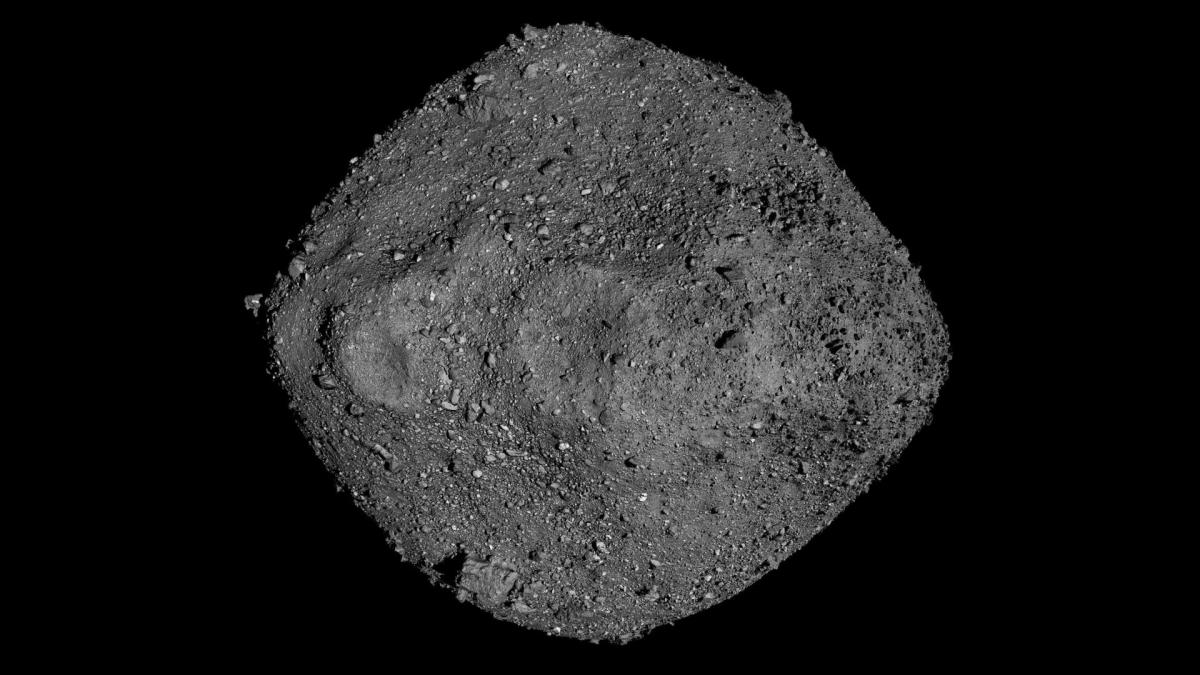
Purchasing through the links in our articles may result in commissions for Future and its syndication partners.

A composite image of the asteroid Bennu, created through observations from NASA’s OSIRIS-REx spacecraft. | Credit: NASA/Goddard/University of Arizona
What are the potential consequences if Earth experiences a catastrophic asteroid impact?
While such an occurrence would certainly be destructive, scientists at the IBS Center for Climate Physics (ICCP) at Pusan National University in South Korea have been investigating how an asteroid collision could alter Earth’s climate and ecosystems post-impact. Their research determined that the chances are remarkably low—about 1 in 2700, or precisely 0.037%—that the asteroid Bennu, which is comparable in size to the Empire State Building, might impact our planet in September 2182. Bennu was also the subject of NASA’s OSIRIS-REx asteroid sampling mission, which briefly landed on the asteroid in October 2020 to collect more than 4 ounces of material and subsequently returned it to Earth, landing in the Utah desert in September 2023.
Although the odds of Bennu colliding with Earth may be concerning, they aren’t entirely surprising. “Typically, medium-sized asteroids strike Earth approximately every 100,000 to 200,000 years. This suggests that our early human ancestors may have witnessed similar planet-altering events, potentially impacting human evolution and our genetic development,” explained Axel Timmermann, a professor at IBS and one of the contributors to the study, in a statement.
While some may fret over Bennu’s slim chances of impact, researchers at IBS employed sophisticated climate models and the Aleph supercomputer to analyze the potential aftermath.
Timmermann and his colleague, Lan Dai, stated in their study, “Depending on the specifics of an impact, a medium-sized asteroid could induce extensive regional to global destruction. In addition to immediate consequences like thermal radiation, earthquakes, and tsunamis, the aftermath could lead to prolonged climatic changes due to significant amounts of aerosols and gases being released into the atmosphere.”
Previous research has thoroughly examined the effects of the much larger Chicxulub asteroid, which impacted around 66 million years ago, likely causing the mass extinction of the dinosaurs. However, it wasn’t the collision itself that triggered the most severe outcomes; the 6-mile-wide (10 kilometers) asteroid expelled vast amounts of dust, soot, and sulfur into the atmosphere, resulting in a global “impact winter.”
Dai and Timmermann noted, “There has been less focus on the impacts of medium-sized asteroid collisions, which occur more frequently than ‘planet-killer’ asteroids but can still have significant global implications.”
The extent of climate disruption from excessive dust depends on various factors, including the amount of dust released into Earth’s atmosphere, the injection location, and its duration in the air.
After evaluating several scenarios using their model, the researchers uncovered that releasing approximately 100–400 million tons of dust into the atmosphere could result in drastic climate upheaval, alter atmospheric chemistry, and diminish global photosynthesis for years following the incident.
Dai stated, “The sudden impact winter would create poor climate conditions for plant growth, likely leading to an initial 20–30% reduction in photosynthesis across both terrestrial and marine ecosystems. This shift would probably cause severe challenges in global food security.”

An artistic depiction of a substantial asteroid hitting Earth, believed to have caused the extinction of the dinosaurs around 65 million years ago. | Credit: Mark Garlick/Science Photo Library/Getty Images
In the direst scenario, the cooling effect from solar dimming caused by the dust could plummet temperatures by approximately 39 degrees Fahrenheit (4 degrees Celsius), decrease global rainfall by 15%, and potentially erode the ozone layer by about 32%. The severity of these consequences may vary greatly depending on local conditions.
Interestingly, the researchers were taken aback by findings from their simulations indicating that plankton in the ocean might recover faster than terrestrial plants. Unlike the rapid maritime decline followed by a sluggish two-year resurgence, oceanic plankton showed recovery within six months, even surpassing typical levels.
Timmermann remarked, “This unexpected response is linked to the iron content present in the dust.” Iron serves as a vital nutrient for algae.
The Earth’s upper crust comprises about 3.5% iron, and the dust generated from an impact could transport these nutrients into the oceans, along with any additional iron from the asteroid itself.
“Depending on the iron concentration in both the asteroid and terrestrial debris propelled into the stratosphere, nutrient-poor zones could be enriched, promoting unprecedented algal blooms,” the scientists elaborated in their publication.
RELATED CONTENT:
— Asteroid Bennu: The squishy space rock that almost engulfed a spacecraft
— Initial analysis of asteroid Bennu samples hints it may be ‘a remnant of an ancient ocean world’
“The predicted overgrowth of phytoplankton and zooplankton could indeed be advantageous for the biosphere, possibly mitigating food shortages due to prolonged drops in terrestrial productivity,” added Dai.
Such an event would undeniably transform our world, with swift cooling and ecosystem disruptions challenging survival. However, gaining insights into these possible effects could prime humanity for such potential futures.
“Our simulated climatic and ecological responses to medium-sized asteroid collisions shed light on potential abrupt events’ impacts on planetary life,” they concluded.
The study “Climatic and ecological responses to Bennu-type asteroid collisions” was published in the journal Science Advances on February 5.









